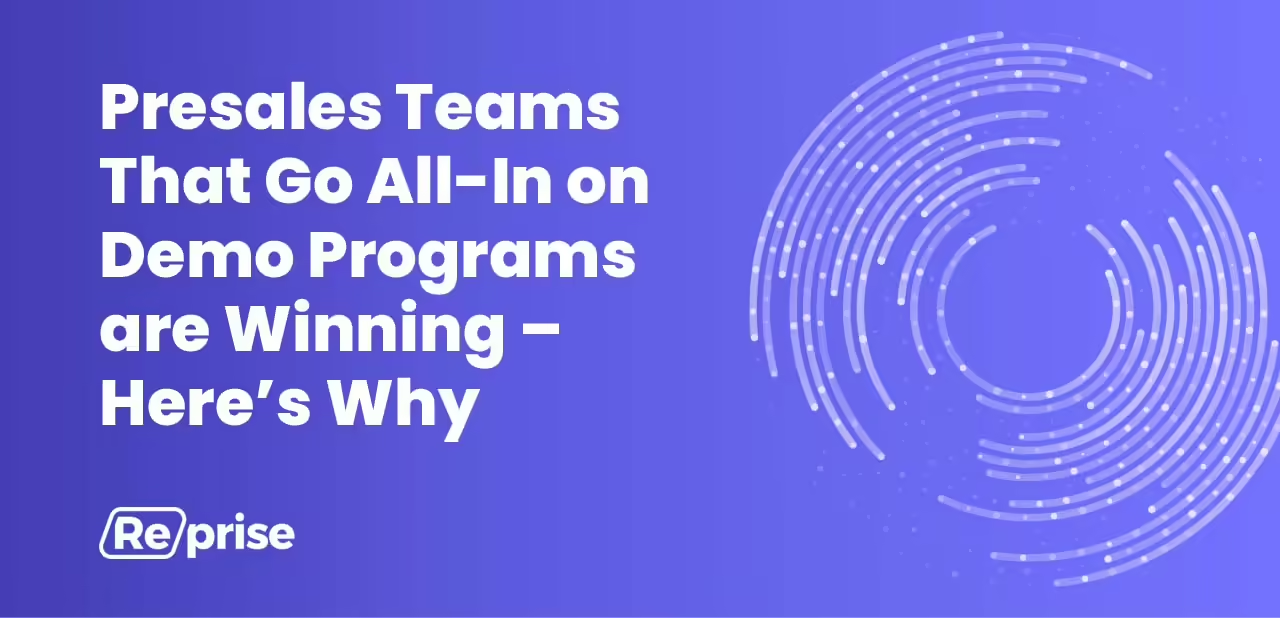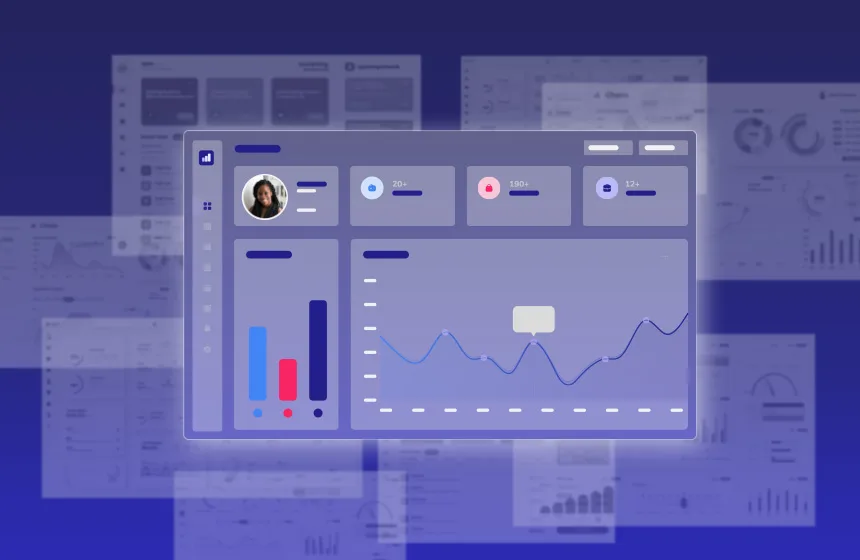Accelerate deals and increase win rates with the leading enterprise demo platform.
Presales Teams That Go All-In on Demo Programs are Winning – Here’s Why

April 3, 2025
Table of Contents
In the world of technology sales, presales teams are the unsung heroes driving the sales engine forward. They focus on accelerating and enabling sales growth, bringing sales and marketing claims to life by showing prospects how a product will solve their unique problems.
But with a skillset that’s in limited supply, presales organizations are often short-staffed and under pressure to effectively support as many opportunities as possible. To address this, many high-performing presales leaders are implementing demo programs that help them make an outsized impact.
In this blog, we’ll explore different approaches to building demo programs, providing insights and actionable tips to help presales leaders get started on this path.
What is a “Demo Program”, and Why Do Demo Programs Matter?
A demo program is a top-down approach to building, centralizing, sharing, and analyzing product demos. Companies that invest in demo programs are usually interested in weaving high quality product experiences into multiple touchpoints across the prospect journey, with the goal to accelerate sales cycles and ultimately grow revenue. Effective demo programs improve go-to-market productivity through scalable, measurable, and repeatable demos.
Demo programs, like the presales role itself, can vary widely between companies. Despite their various approaches and implementation paths, the common thread is this: Well-constructed demo programs empower presales teams to make a greater impact on the business.
This impact is usually measured in one of the following ways:
- Faster, shorter sales cycles: Demo programs put product into the hands of prospective users early and often throughout the buying journey. Prospects are better equipped to self-qualify early on, and to educate themselves without needing 1:1 guidance from a presales resource — which we all know can be a bottleneck when presales skillsets are in limited supply. Demo programs also make it easy to share product experiences with stakeholders across the buying committee asynchronously, without the headache of scheduling (and often rescheduling) time for multiple live, bespoke meetings.
- Presales efficiency gains: By standardizing the demo process and packaging up demo resources that can be tailored and shared at scale, presales teams spend more of their time on the outliers – highly strategic and/or well qualified prospects that warrant their technical expertise.
- More consistent messaging: Demo programs ensure the entire team is aligned on core messages and how they articulate the benefits of each feature, which improves positioning and brand strength.
Demo Programs Take Different Forms
Each company may have a unique interpretation of what a demo program entails, depending on their product, selling motion, team, and other factors. Many demo programs encompass multiple use cases including customized live demonstrations, guided product tours, sales leave-behinds, and dedicated demo or sandbox environments.
But most demo programs start with a single use case – which usually aligns with the biggest pain point or bottleneck in their go-to-market motion – and expand into a scalable, repeatable program.
Here are a few of the most common approaches we’ve seen at Reprise, where we’ve helped hundreds of organizations stand up enterprise-grade demo programs.
Starting Point A: Grow the Funnel with Interactive Product Tours
Many organizations today are under pressure to generate more leads with leaner sales and presales teams. Meanwhile, buyers increasingly are PLG-forward and want on-demand, self-service options to see and try software products before engaging with a human. The culmination of these trends is leading more and more SaaS providers to launch demo programs, starting with interactive product tours.
Interactive product tours are on-demand demos that provide a self-guided product experience. Buyers can understand how products work at their own pace and on their own time, allowing them to wait to engage with a salesperson until after they’ve self-qualified. For SaaS providers, product tours have become a lead generation engine that allows sales and SE staff to spend their time with more qualified leads instead of chasing the top of the funnel.
Pendo is one example of a SaaS provider that launched a demo program with product tours, after deciding they needed an easier way to showcase their product experience platform than by spinning up trials, which often required presales support.
Today, Pendo’s website serves more than 40,000 product tours per week. Their product tour library has become the highest performing CTA on the Pendo.io website, and trial support is reserved for well-qualified prospects.
Organizations that begin with product tours focus initially on measuring their success based on top of funnel growth and marketing conversions, and then often expand that library of demos into shared resources for a sales team. Integrating with CRM and marketing automation tools is important for demonstrating ROI. Once value has been realized, many teams widen the aperture of their demo program’s impact further down the funnel, whether via live demo support or sales leave-behinds (or both).
Starting Point B: Accelerate Opportunities with Customized Live Demos
Companies with complex technology products and/or those selling to a diverse customer base (i.e. covering a wide range of industries) often rely on live product demonstrations as the linchpin of every sales cycle. Live demos are instrumental in showing how to apply the technology to a particular use case and/or company, but it’s time-consuming and costly to maintain multiple dedicated demo environments.
Lining up the right resources, preparing, and delivering custom demos mid-funnel can become quite the bottleneck. Many organizations end up with a demo environment that doesn’t include the latest and greatest features simply because keeping the demo environment up to date with every new feature that’s released becomes a backlog task that falls down the priority list.
This was the case for eCommerce solution provider Digital River when they decided to bring in a demo creation platform. They’d historically relied on sales engineers to set up demo environments before each live demo, which required some effort to adapt the environment to be customer-facing, since some demo environments served multiple purposes. They couldn’t jump into a demo on the first call, which created risk of losing a prospect between the first call and second.
Implementing a demo creation platform has transformed the Digital River team’s ability to showcase the product in early sales cycles. Sales reps can now demo “instantly and at will” using Reprise, without needing SEs to join every early prospect conversation. They can also be much more adaptive when speaking with customers, showing aspects of the product they’ll care about most based on the real-time feedback they receive. This real-time feedback helps to qualify whether the solution is relevant earlier in cycles, improving sales cycle efficiency.
Companies that start with live demos often repackage that work and tackle sales leave-behinds as their next demo program use case, as is the case at Digital River. From there, they mature their program further by building libraries of assets that can be customized, shared across teams, and added to the website as guided tours.
The long-term goal for most companies starting their demo program journey with live demos is to automate parts of the demo process that will help them scale while maintaining a high level of personalization. Finding the right balance of customization with scalability is key.
Starting Point C: The All-in Product Experience via Dedicated Demo or Sandbox Environment
For organizations that want or need the ability to deliver deeper demos offering a complete application experience, cloning the entire application in a dedicated demo or sandbox environment can be the preferred starting point. But maintaining these environments and their infrastructure gets very costly, very fast.
Demo creation platforms can alleviate these headaches by hosting end-to-end application clones in a secure environment. This approach frees sales engineering resources and equips both sellers and end users with a demo environment that works perfectly every time, without any of the maintenance headaches or anxiety of wondering whether the software might fail.
Companies that begin their demo program with a dedicated demo or sandbox environment appreciate the cost and SE resource savings that can be achieved with demo software. They identify use cases where less customized product experiences are possible, and expand their demo program to encompass support for live demos, leave-behinds, or product tours.
Databricks is one example. Their complex product had historically leaned heavily on proofs-of-concept (POCs), which required a significant presales investment in terms of human capital and time for every sales opportunity. In an effort to scale, they’ve implemented a demo program where customers can engage with live demos, product tours, workshops, leave-behinds, and custom demo environments all as alternative options to the POC. This has led to greater alignment across the team and shorter sales cycles.
Advice from Databricks’ Ashita Saluja, Senior Director of Field Engineering Strategy & Scale: “Keep the customer journey in mind. It’s more important than the tool you’re using.”
Identify the most important use cases to your team and the one(s) where you can make a quick win, and focus there first. Then, expand and prove it out again.
Reprise Can Help You Get Started
Demo programs help high-performing presales teams accelerate sales cycles, boost efficiency, and improve the customer experience. But it might be overwhelming to think about how and where to start.
Reprise can help! We offer a powerful platform designed to help presales teams create, manage, and deliver effective demo programs. With Reprise, you can automate demo creation, ensure consistency in your messaging, and track the impact of your demos on sales outcomes. Contact us to discuss creating the right demo program for your org.
Whether you choose a tailored live demo, an on-demand product tour, or a demo sandbox environment approach, the key is to start small, prove the value, and scale effectively. With the right strategy and tools, your demo program can become a powerful driver of sales success.






